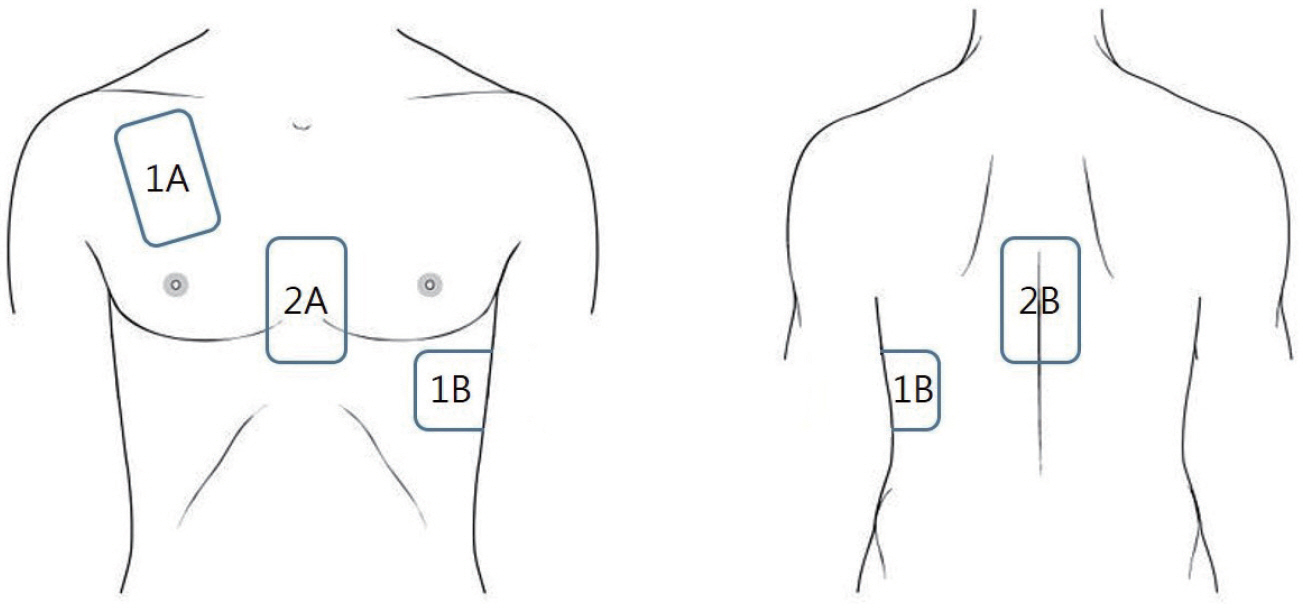Acute Crit Care.
2021 Feb;36(1):67-69. 10.4266/acc.2020.00122.
Successful resuscitation of refractory ventricular fibrillation with double sequence defibrillation
- Affiliations
-
- 1Department of Emergency Medicine, Korea University Guro Hospital, Seoul, Korea
- KMID: 2513256
- DOI: http://doi.org/10.4266/acc.2020.00122
Abstract
- In cardiac arrest, if the initial rhythm is ventricular fibrillation (VF) or pulseless ventricular tachycardia, the survival rates are high and good neurologic outcomes are expected. However, the mortality rate increases when refractory ventricular fibrillation (RVF) occurs. We report a case of RVF that was successfully resuscitated with double sequence defibrillation (DSD). A 51-year-old man visited the emergency department with chest pain. The initial electrocardiography showed markedly elevated ST-segment on V1–V5 leads, and VF arrest occurred. Although 10 defibrillations were administered over 20 minutes, there was no response. Two rounds of DSD were performed by placing additional pads on the patient’s anterior-posterior areas and sequentially applying the maximum energy setting. The patient returned to spontaneous circulation and was discharged with cerebral performance category 1 after 14 days of hospital admission. Therefore, DSD could be an option for treatment and termination of RVF.
Figure
Reference
-
1. Benjamin EJ, Blaha MJ, Chiuve SE, Cushman M, Das SR, Deo R, et al. Heart disease and stroke statistics-2017 update: a report from the American Heart Association. Circulation. 2017; 135:e146–603.
Article2. Sakai T, Iwami T, Tasaki O, Kawamura T, Hayashi Y, Rinka H, et al. Incidence and outcomes of out-of-hospital cardiac arrest with shock-resistant ventricular fibrillation: data from a large population-based cohort. Resuscitation. 2010; 81:956–61.
Article3. Soar J, Nolan JP, Böttiger BW, Perkins GD, Lott C, Carli P, et al. European Resuscitation Council Guidelines for Resuscitation 2015: section 3. Adult advanced life support. Resuscitation. 2015; 95:100–47.4. Cheskes S, Wudwud A, Turner L, McLeod S, Summers J, Morrison LJ, et al. The impact of double sequential external defibrillation on termination of refractory ventricular fibrillation during out-of-hospital cardiac arrest. Resuscitation. 2019; 139:275–81.
Article5. Emmerson AC, Whitbread M, Fothergill RT. Double sequential defibrillation therapy for out-of-hospital cardiac arrests: The London experience. Resuscitation. 2017; 117:97–101.
Article6. Ross EM, Redman TT, Harper SA, Mapp JG, Wampler DA, Miramontes DA. Dual defibrillation in out-of-hospital cardiac arrest: a retrospective cohort analysis. Resuscitation. 2016; 106:14–7.
Article7. Coppler PJ, Abella BS, Callaway CW, Chae MK, Choi SP, Elmer J, et al. Variability of extracorporeal cardiopulmonary resuscitation utilization for refractory adult out-of-hospital cardiac arrest: an international survey study. Clin Exp Emerg Med. 2018; 5:100–6.
Article8. Park JH, Song KJ, Shin SD, Ro YS, Hong KJ. Time from arrest to extracorporeal cardiopulmonary resuscitation and survival after out-of-hospital cardiac arrest. Emerg Med Australas. 2019; 31:1073–81.
Article
- Full Text Links
- Actions
-
Cited
- CITED
-
- Close
- Share
- Similar articles
-
- Implantation of ICD in a Ventricular Fibrillation Patient with a High Defibrillation Threshold
- A case of heat stroke in which first symptom as cardiac arrest with ventricular fibrillation
- Extracorporeal Life Support After Prolonged Resuscitation for In-Hospital Cardiac Arrest due to Refractory Ventricular Fibrillation: Two Cases Resulting in a Full Recovery
- Complete Recovery after Prolonged Resuscitation Using Extracorporeal Membrane Oxygenation for In-hospital Arrest Due to Refractory Ventricular Fibrillation
- The potential mechanism of the detrimental effect of defibrillation prior to cardiopulmonary resuscitation in prolonged cardiac arrest model


